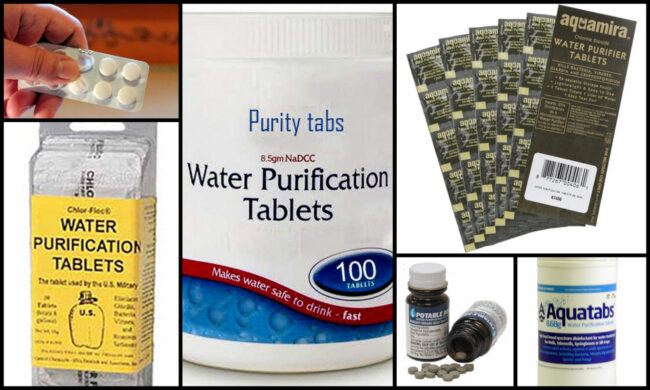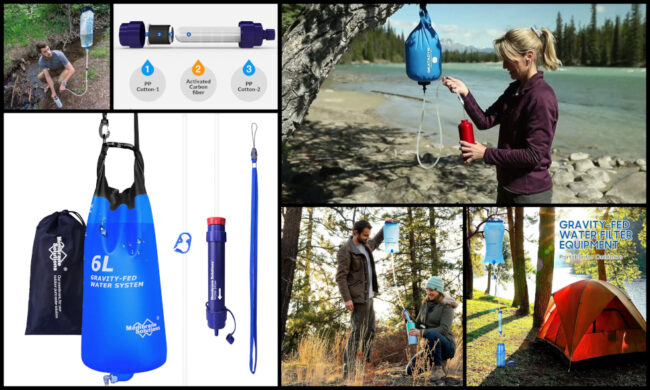Water Purification Systems
There are several things that can kill you in the backcountry; exposure, hypothermia, severe weather, large predator animals, but one of the absolute worst is contaminated drinking water. Even though a running stream looks clean assume that it’s teaming with bacteria and/or viruses that can put you in a world of hurt.
The first rule of drinking water in the wilderness is TREAT IT!! This can be done either by bringing water to a “rolling boil” for at least one minute, chemically, or through a filtration system. I’ve used all three systems and as always there are pros and cons to each.
Boiling water works great, and pretty much kills anything that can hurt you. The downside to this process is that it takes time to set up a fire or stove after acquiring your water. Also, boiling doesn’t necessarily deal with any chemicals that may be in the water, so there is that. Pretty much all filtration systems utilize activated charcoal and that goes a long way to making better drinking water.
Chemical treatment basically consists of dropping a tablet or some sort (iodine or other chemical) into a container of water, waiting for it to do its thing and drinking it. With iodine tablets you’ll find out very quickly that the crystal-clear mountain water you thought bacteria-free was teaming with life. In almost every case, the water will turn iced-tea colored. The disadvantage to chemical treating of water is that it can leave a “funky” aftertaste. Still, it beats the other possibilities. In recent years manufacturers have developed an after-treatment pill to neutralize the aftertaste. A few drops of bleach will also do the trick. Hydrochlorite (bleach) is the same stuff that most water companies use to treat your water at home. Be very careful to not use too much as it can cause some problem too. There are now other chemicals on the market as well, and they all do the job.
The preferred method for most backpackers is the filtration method. Small, effective systems are available at most sporting goods stores. The main thing to make sure of is that your system filters down to about .5 microns. Anything larger than that won’t be very effective. If possible, get a filtering system that removes viruses as well. For years I used the Sweet-Water Guardian system. To date, I’ve never gotten sick in the back country. There are several good systems on the market.
The Guardian system is of the pump type. You basically drop a line into a water source and place another line into your water bottle or canteen. Then you pump, and pump, and pump until your container is filled up to your satisfaction. To be honest, even though this is a very safe system to use and will clean up your source water, it’s very labor intensive and can take quite a while to do the job. This type of filtration system has been popular with backpackers for decades.
In recent years a new trend has come forth, getting away from the chore of pumping water through a filter. One of the latest is the Survival Straw system. You basically use an inline filter and drink straight from the water source like a stream or lake. Super efficient and safe and easy. The big downside to this is that you have to lie on the ground to get to the water and probably will get wet in doing so. You’ll need to either use a ground cloth to keep dry, or you can use a modified straw system by dipping a bottle into the water and use an adapter to move that water to your drinking containers or drink from the source bottle directly through the straw.
One of the newer systems on the market is the dunk & press filtration format. This system has you dipping a water collection bottle into the source, then pressing a filter down into the same container. The water is pushed up through the filter as you press it down into the bottle, and the water that is now in the container (above the filter membrane) is clean and you can drink out of the top of the container just like any water bottle. You’ll notice that the photos below are of the same brand. Best as I can figure out they’re the only company that makes this system. The reason I’m drawn to this one is because I’ve seen it on several Survivalist videos the last little bit and it’s becoming increasingly popular with that very particular group.
Last, and certainly not least is the new generation of gravity-assisted purification systems. With these you collect water either in a bucket bag or some type of bottle, hang it up and let gravity feed the source water through an inline filter (basically a Survival Straw) via a tube and then by putting your drinking water container right under the filter, the now clean water now drips down and fills up your water bottle. The only effort here is walking to the bank to scoop out the source water, gravity does all the real work. FYI, you can use the inline filter as a stand-alone filter just like the Survival Straw as it has a mouthpiece on it too. This is the system I’ve gone with, though I do intend to get a dunk & press one too for fast water access while hiking, saving having to dig out the larger system out of my pack. That I’ll save for camp.
All the systems I’ve talked about here are lightweight and easy to fit into a backpack. The smallest and lightest of course are the purification tablets, but with those you need at least 45 minutes to let the chemistry work. The quickest is the Survival Straw and to me at least, the gravity feed system is best for the campsite. They’re all good and all work.
You may want to go to www.backpacker.com for more information on the latest systems. They’re an excellent source for up-to-date information on virtually everything used by outdoors enthusiasts. Their annual Gear Guide has become the equipment bible for many backpackers.
Last modified on: February 22nd 2022.




